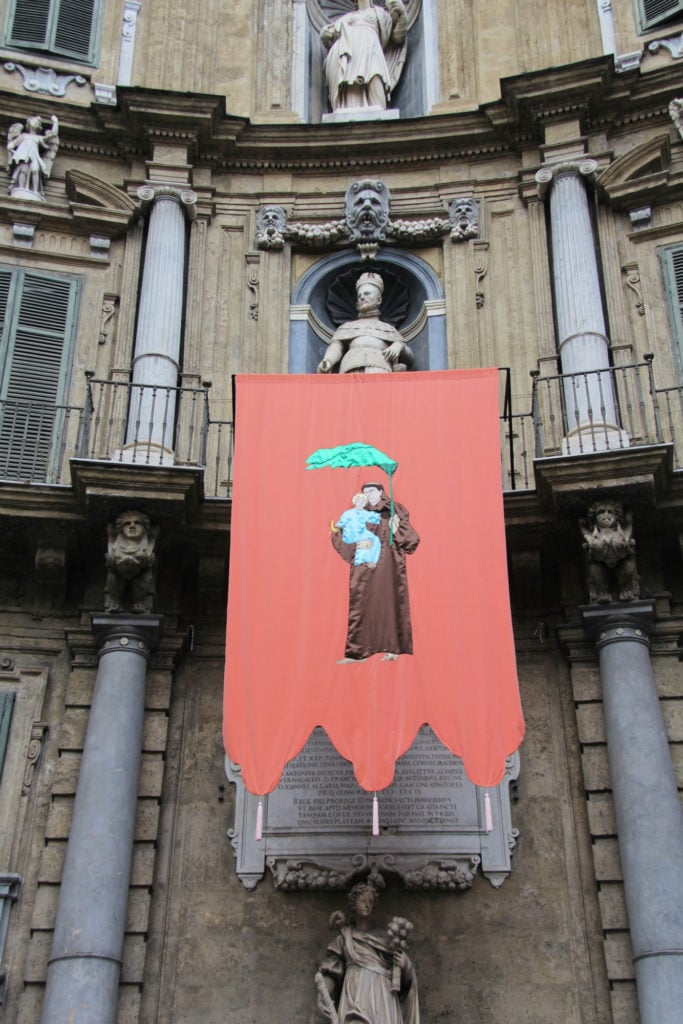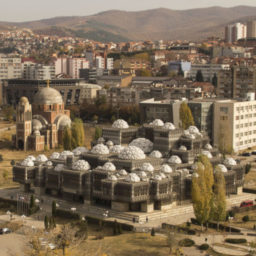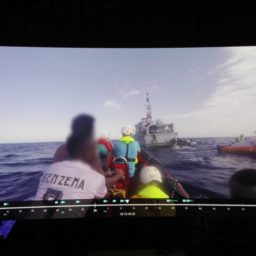Manifesta 12 describes our current world as one carved by opposing forces of nurture and violence. Sensitive to its locale at a cross-cultural axis of the Mediterranean, “The Planetary Garden: Cultivating Coexistence” approaches Palermo less as a static location than as a junction at which flows of trade, conflict, information, ideas, people and capital tangle like strands of spaghetti con le sarde.
Manifesta 12 looks to the garden. On the abstracted global scale, the metaphor broadcasts beauty, growth and good things: An Edenic site of peaceful coexistence for diverse specimens and mutual care. On the specific European scale, by contrast, it bespeaks colonial narratives of enslaved labor, “discovery” of the exotic, and classification systems that erase non-European knowledge.
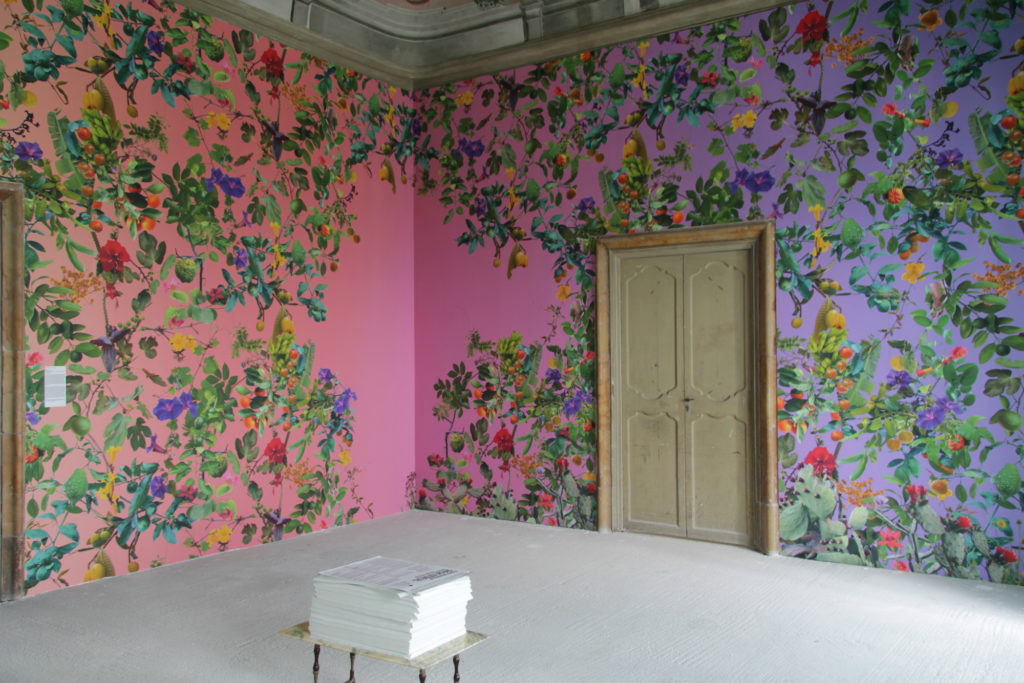
Fallen Fruit’s installation at the Palazzo Butera, courtesy of the artist, photo by Wolfgang Trager, copyright Manifesta 12 Palermo.
In the Palazzo Butera, a gorgeous, crumbling palace dating back to the 17th century, are found Manifesta’s sunniest uplands. The tiles of Renato Leotta’s terracotta floor were shaped by falling lemons in an orchard, reconnecting this royal dwelling with the labor in its fields. The LA collective Fallen Fruit have printed a gorgeous, gaudy wallpaper patterned with the public fruiting trees of the city which they have also mapped: free fruit to nourish the commons.
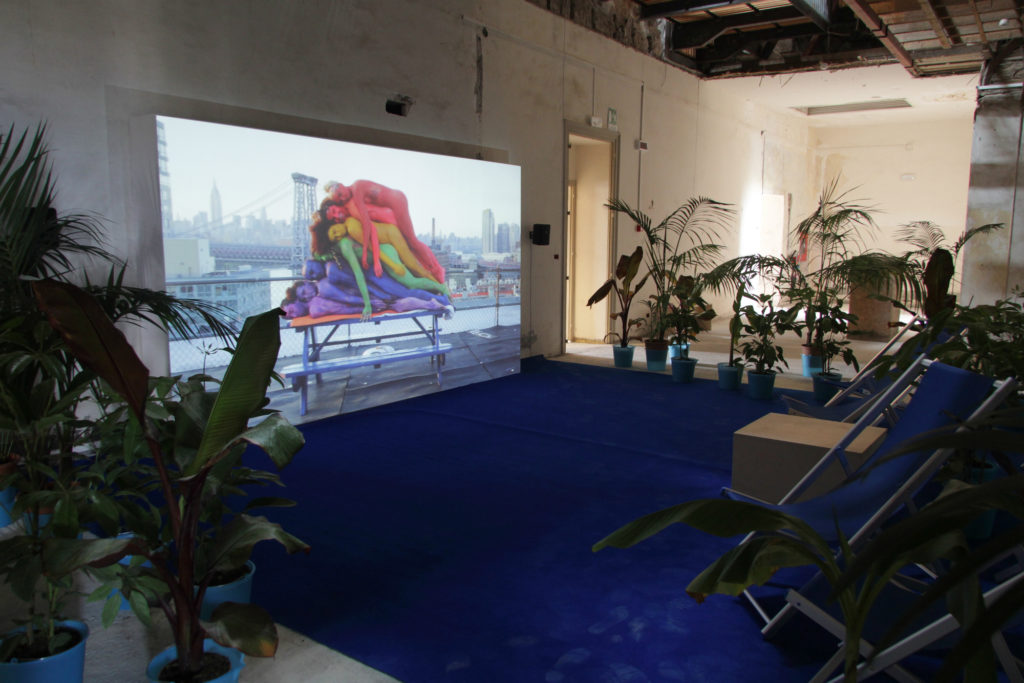
Melanie Bonajo’s Night Soil (installation), courtesy of the artist, photo by Wolfgang Trager, copyright Manifesta 12 Palermo.
Melanie Bonajo’s Night Soil video trilogy explores the lengths alienated urbanites go to reconnect to nature-derived practices and belief systems. The films explore vogues for guided ayahuasca trips, sexual therapy derived from tantric traditions, and back-to-the-land food cultures as a form of social healing. Disquieting subtexts of preciousness, solipsism and privilege surge in and out of view—the title is a euphemism for human waste—while Bonajo has fun making pictures with her characters, dressing them in bodypaint, wigs, and costumes fashioned from plants, feathers, and household debris.
By contrast to such self-absorption, Matilde Cassati’s Tutto felt like a gift from artist to audience. On Saturday morning (June 16), at a crowded crossroad draped with the artist’s stitched banners, Tutto commenced with powerful drumming, joined by the peal of church bells and finally the blast of air cannons shooting paper confetti, sparkling streamers and pictograms into the bright air above the crowd. Amid international obsessions with security and terrorism, the reclaiming of public space for a moment of intense and pleasurable shared experience felt significant.
At the city’s botanic gardens—the Orto Botanico—human creativity paled beside the sculptural forms created by giant Ficus trees and baroque cacti. Bridging the gap, Zheng Bo’s video work Pteridophilia followed a group of young men getting amorous (at times vocally so) with ferns in a park in Taiwan. An act I can only describe as frondilingus took place. Seed was apparently spilled. Zheng suggests such eco-queer activity as an appreciation of plant species on equal terms. (What of consent, though?)
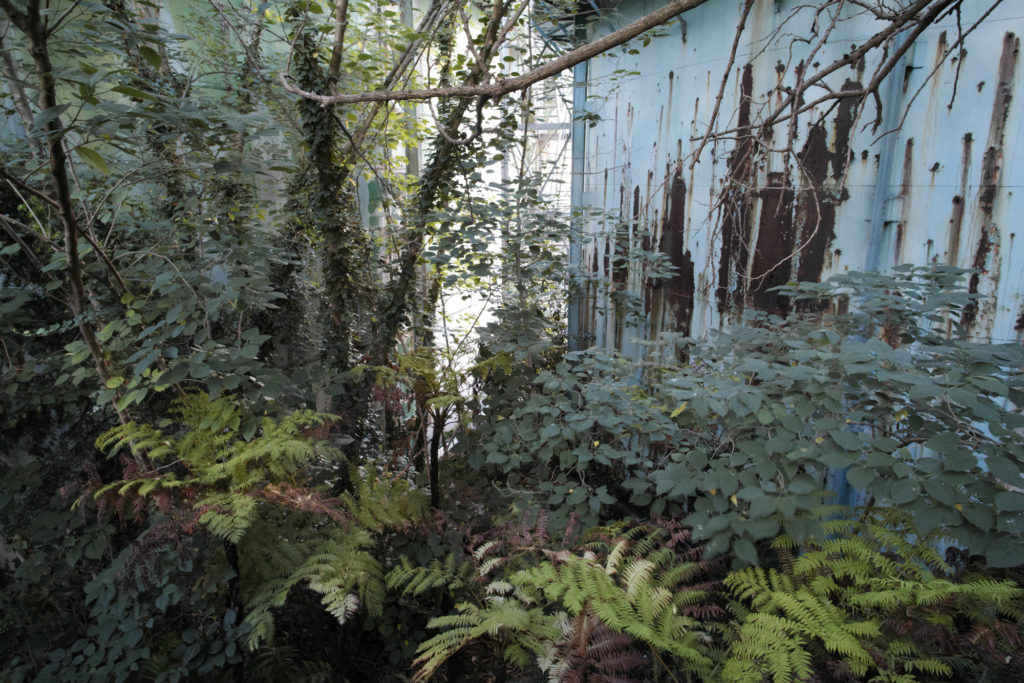
Michael Wang’s installation (detail), Orto Botanico, courtesy of the artist, photo by Wolfgang Trager, copyright Manifesta 12 Palmero.
A three part work by Michael Wang charts plants’ role in the anthopocene: as coal, here photographed in its barky detail; flourishing, adapted, on a toxic post-industrial site viewed via raised platform at the garden’s edge: and to what came before them. A park fountain colonized by greeny-blue cyanobacteria nods to the Oxygen Holocaust 2.3 billion years ago, when oxygen was first produced by photosynthesis, devastating life on earth.
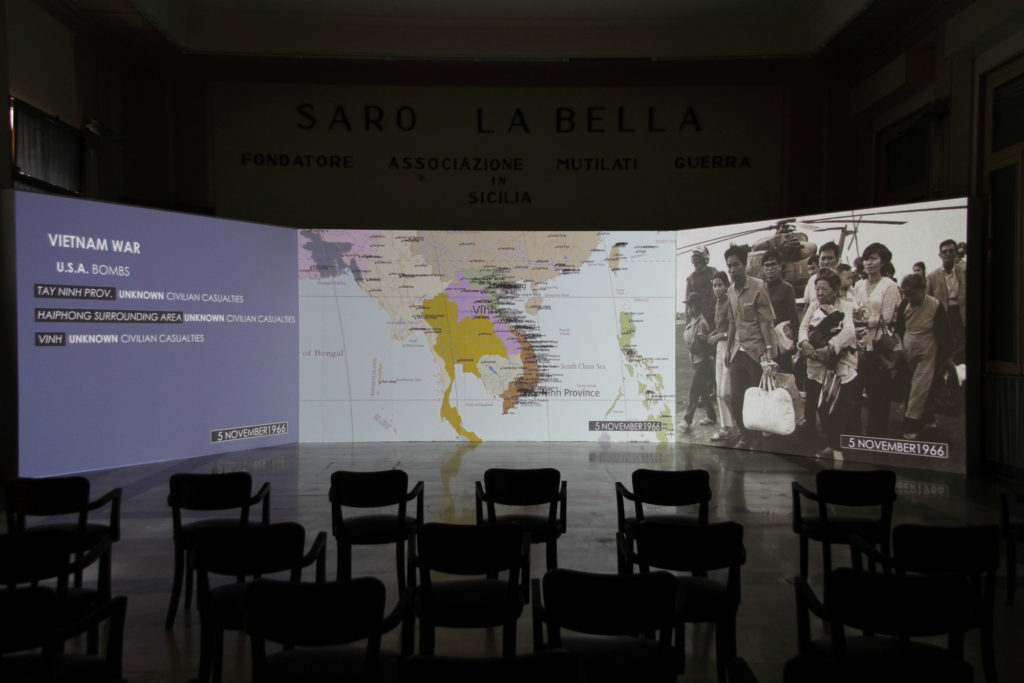
Cristina Lucas, Unending Lightning (still), courtesy of the artist, photo by Wolfgang Trager, copyright Manifesta 12 Palermo.
Human—rather than bacterio/evolutionary—violence takes the throne in The Out of Control Room, a segment of the program looking, broadly, at machinations of the state. Cristina Lucas’s devastating Unending Lightning (2015–ongoing) occupies the martial hall of Casa del Mutilado. Eight years lay between the first piloted, powered flight in 1903 and the first aerial bombardment during the Italo-Turkish war. Death from above has not stopped. Over six hours, Lucas charts every aerial bombing of civilians since 1911. Changing second by second, a screen to the left lists the location, the power responsible and the civilian casualties; the central screen is a world map onto which missiles fall from an aerial vantage point; the right offers a single unflinching snapshot of the devastation caused each time. Jesus: the horror of it. I sat weeping. To stand up and walk away felt like refusal to bear witness.
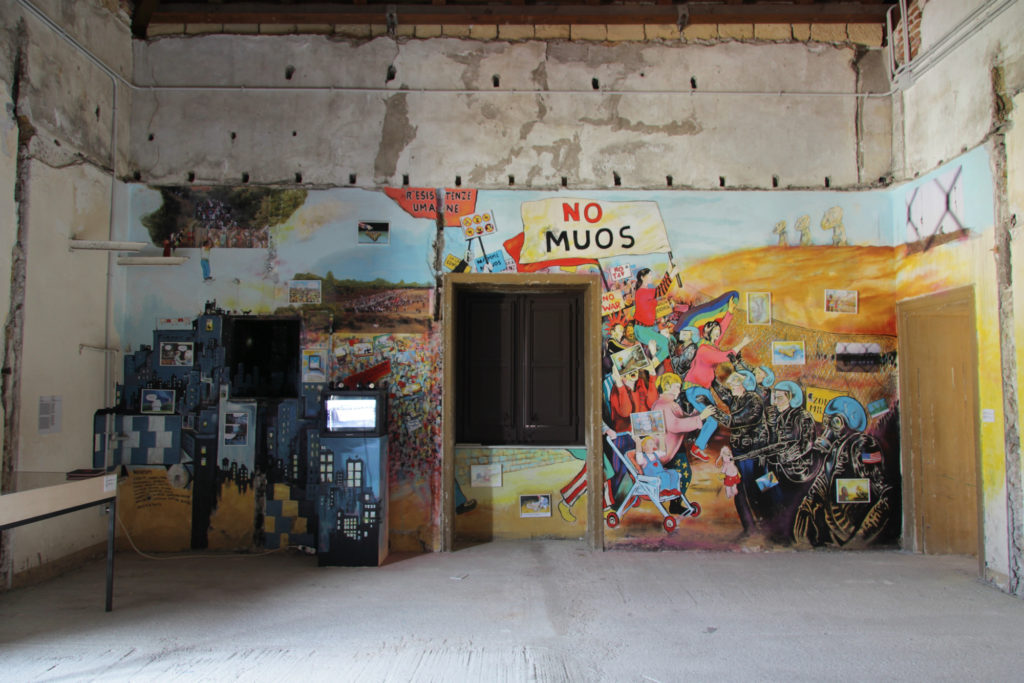
Tania Bruguera’s work chronicles opposition to secret military bases in Sicily or MUOS, courtesy of the artist, photo by Wolfgang Trager, copyright Manifesta 12 Palermo.
Both Laura Poitras and Tania Bruguera engage with the underlying mechanics of state violence. One of four global ground stations of the MUOS (Mobile User Objective System) is installed within Sicily’s protected Sughereta Park in Niscemi. MUOS co-ordinates and commands US military systems around the world, including drone strikes.
Bruguera worked with local protest groups, documenting direct action and media coverage. One wall of the Palazzo Ajutamicristo carries a mural portraying the force of local opposition to the base station.
Poitras worked collaboratively as well, commissioning a series of diverse video works from Palermitan filmmakers exploring the US military presence in Sicily, past and present. Poitras evokes links both between the ground station and its remote impact, and between military and “civilian” technology. In an outer room, a small monitor screen shows a huge military drone prepping for deployment. Poitras’s own drone-shot video is projected in a dark chamber, the camera hovering through a mossy cork forest to the vast parabolic antennae on cleared land at its center. Alongside, archive footage of missile launches suggests the fire and destruction occurring at invisible distance.
Not afraid to explore big ideas in depth, Manifesta 12 is heavy on data visualizations, social practice, and documentary. Here, too, are architectural responses to climate change, political corruption and failing infrastructure. Gilles Clément and Coloco planted communal gardens in the run down ZEN housing estate. Cooking Sections worked with the university to test ancient irrigation techniques adapted to arid zones. These and other projects should come to fruition months if not years after the departure of VIP visitors: this is a biennial that aims for enduring local impact.
Manifesta 12 soars in those moments where powerful location and tightly conceived works come together. In the state archives, a spectacular hall filled with ancient, dusty ledgers hosts a short video work by MASBEDO. The work by the artists Nicolò Massazza and Iacopo Bedogni shows a hapless marionette—a puppet unsure of the forces guiding him. In the Alhambra-inspired mosaic chambers of the fortified Palazzo Forcella De Seta, Patricia Kaersenhout has poured a mountain of blessed salt. In the Caribbean enslaved people dreamed of flying back to Africa: legend had it the consumption of salt would weigh them down. As a gesture of commemorative release the artist invites visitors to take salt and release it back into water.
There is not space enough here to list all the highlights (or indeed disappointments), but overall, Manifesta 12 felt tightly curated, thoughtful and engaged. Before a curatorial team was even appointed, the board commissioned an urban study of Palermo: a practice the nomadic biennial plans to take forward to each host city. I like the result.
“The Planetary Garden: Cultivating Coexistence,” Manifesta 12, through November 4, various venues, Palermo, Sicily.
